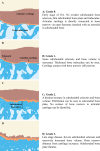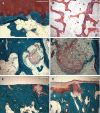Subchondral bone histology and grading in osteoarthritis
- PMID: 28319157
- PMCID: PMC5358796
- DOI: 10.1371/journal.pone.0173726
Subchondral bone histology and grading in osteoarthritis
Abstract
Objective: Osteoarthritis (OA) has often regarded as a disease of articular cartilage only. New evidence has shifted the paradigm towards a system biology approach, where also the surrounding tissue, especially bone is studied more vigorously. However, the histological features of subchondral bone are only poorly characterized in current histological grading scales of OA. The aim of this study is to specifically characterize histological changes occurring in subchondral bone at different stages of OA and propose a simple grading system for them.
Design: 20 patients undergoing total knee replacement surgery were randomly selected for the study and series of osteochondral samples were harvested from the tibial plateaus for histological analysis. Cartilage degeneration was assessed using the standardized OARSI grading system, while a novel four-stage grading system was developed to illustrate the changes in subchondral bone. Subchondral bone histology was further quantitatively analyzed by measuring the thickness of uncalcified and calcified cartilage as well as subchondral bone plate. Furthermore, internal structure of calcified cartilage-bone interface was characterized utilizing local binary patterns (LBP) based method.
Results: The histological appearance of subchondral bone changed drastically in correlation with the OARSI grading of cartilage degeneration. As the cartilage layer thickness decreases the subchondral plate thickness and disorientation, as measured with LBP, increases. Calcified cartilage thickness was highest in samples with moderate OA.
Conclusion: The proposed grading system for subchondral bone has significant relationship with the corresponding OARSI grading for cartilage. Our results suggest that subchondral bone remodeling is a fundamental factor already in early stages of cartilage degeneration.
Conflict of interest statement
Figures






References
-
- Sellam J, Herrero-Beaumont G, Berenbaum F. Osteoarthritis: pathogenesis, clinical aspects and diagnosis. EULAR compendium on rheumatic diseases. Italy; BMJ Publishing Group LTD; 2009;p444–63.
-
- Moskowitz RW. The burden of osteoarthritis: clinical and quality-of-life issues. Am.J.Manag.Care 2009;15:S223–9. - PubMed
-
- Pastoureau PC, Chomel AC, Bonnet J. Evidence of early subchondral bone changes in the meniscectomized guinea pig. A densitometric study using dual-energy X-ray absorptiometry subregional analysis. OA Cartilage 1999;7:466–73 - PubMed
MeSH terms
LinkOut - more resources
Full Text Sources
Other Literature Sources
Medical
Research Materials
Miscellaneous

